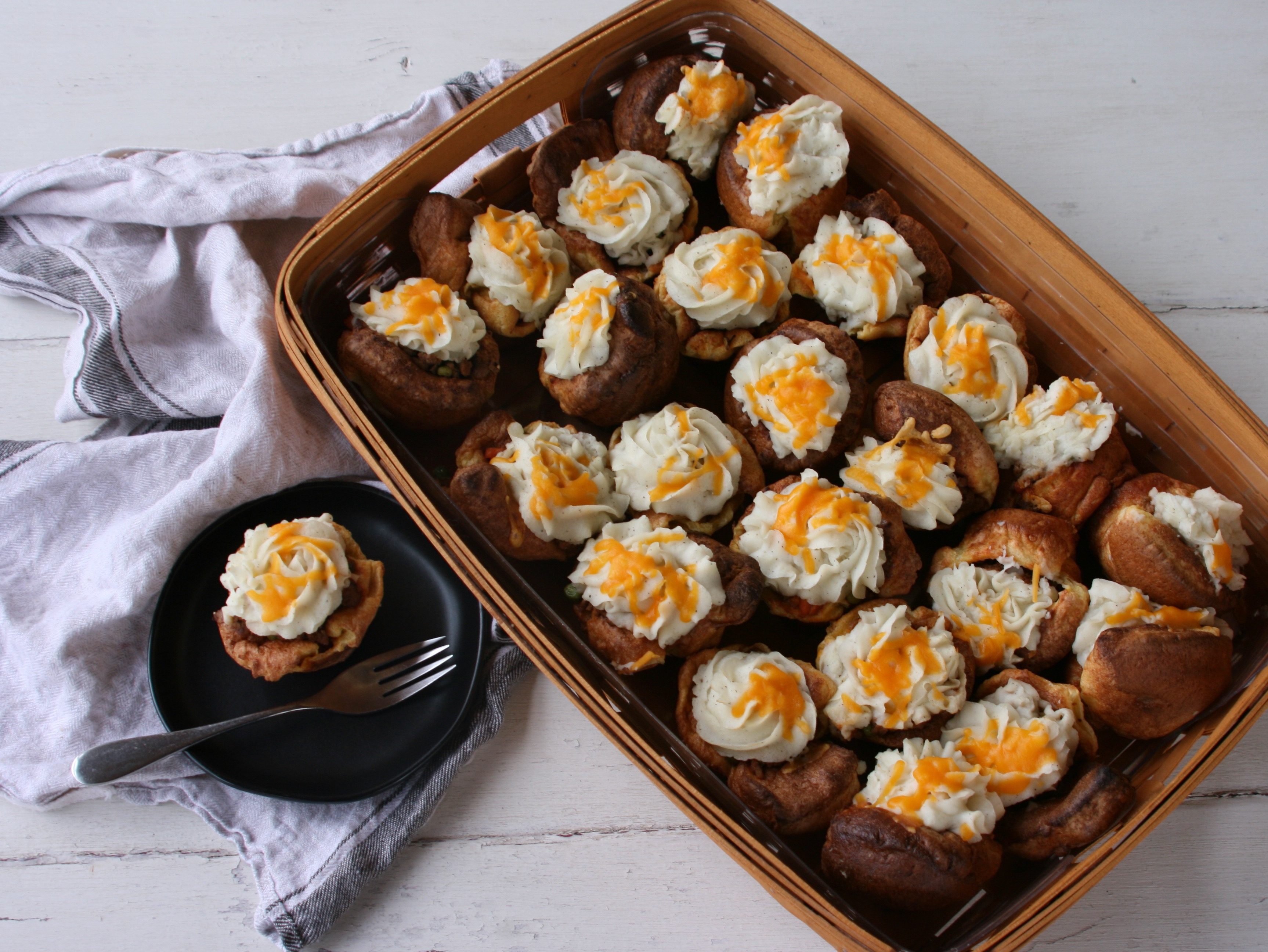For the origins of Yorkshire pudding, we must go back to The Whole Duty of a Woman: Or, an Infallible Guide to the Fair Sex, the 1737 book offering “rules, directions, and observations, for … conduct and behavior through all ages and circumstances of life, as virgins, wives, or widows, … [i]n which are comprised all parts of good housewifery, particularly rules and receipts [recipes] in every kind of cookery.”
I referenced this book in my chocolate tart post as the first known publication of a recipe for that confection. Another recipe published in The Whole Duty of a Woman was for “dripping pudding,” which turns out to be the first reference to what would become known as Yorkshire pudding.

The method for dripping pudding was basically to make a pancake-like batter and pour it into the dripping pan under a roast as it was cooking on a spit. The batter would puff up like a soufflé and form a crispy crust as it cooked in the sizzling fat dripping off the meat. It also absorbed the meat drippings, which were too precious to waste, adding both color and flavor to the finished pastry. These “puddings” (more on that later) became a separate course served before the roast. For pub owners, that meant the appetites of their hungry, working-class clientele were sated before the more expensive meat course, stretching the budget and allowing them to serve more patrons.
Ten years after that first recipe, Hannah Glasse, in her 1747 acclaimed cookbook The Art of Cookery Made Plain and Easy, provided a similar recipe under the name A Yorkshire Pudding. She recommended serving it with melted butter, calling it “an exceeding good pudding; the gravy of the meat eats well with it.”

Americans who are unfamiliar with Yorkshire puddings (here in the U.S. we call them popovers) may be confused by the name. Indeed, in the U.K., the term pudding can be used for any sweet dessert but also can refer to both sweet and savory dishes made with flour and often steamed, such as suet pudding (e.g., spotted dick), steak and kidney pudding, or sticky toffee pudding. The earliest references to puddings, though, usually refer to what we would call sausages — meat and other ingredients stuffed into animal intestines and either cooked or smoked. A few have maintained that title to this day, namely black pudding (i.e., blood sausage) and white pudding. Haggis would fit this category, as well. Yorkshire pudding seems to be an outlier here, but perhaps the original dripping pudding was considered steamed, since it was cooked in the meat drippings over a fire.
As for the Yorkshire pudding’s connection to Yorkshire in the north of England, one theory is that the coal miners of the region were provided with free coal, which was essential to creating a hot fire for roasting, and they could afford to buy the meat, a rare luxury for many in those days.

Nowadays, Yorkshire puddings have become synonymous with the Sunday roast, a British tradition of eating a beef roast dinner complete with vegetables, potatoes, and gravy to sop up with the Yorkshire puds. The love of Brits for their beef dates at least as far back as the 1600s, when the Yeomen of the Guard were given large rations of beef, so much so that Count Cosimo III de’ Medici, Grand Duke of Tuscany, upon visiting the English court, referred to them in a letter as Beefeaters, which has stuck to this day. By the 1800s, the French would jokingly refer to the English as “rosbifs,” (the frenchified version of roast beefs) much like the English called the French “frogs.”
For this signature challenge, the Great British Bake Off judges were asking for 24 Yorkshire puddings stuffed with a savory filling. Both Jane and Selasi modeled their Yorkshire puddings on the Sunday roast.

Mel Giedroyc reminded viewers that a successful Yorkshire pudding depends on the consistency of the batter: “Too thick and the puddings won’t rise, too runny and they won’t hold their structure.” Pouring the batter into a pan with hot fat and then putting it directly into a hot oven will help the puddings start to cook immediately, creating the steam needed for a good rise, she added. But once they’re in the oven, as both Mary Berry and Val noted, “it’s in the lap of the gods.”
Every baker in the Great White Tent seemed to have a slightly different method for making Yorkshire puddings. Most agreed that resting the batter before cooking helped the puddings rise better. Some refrigerated it during the rest and some didn’t. Traditionally, it’s preferable to cook them in the fat from the roast drippings, but some of the bakers used lard, and Andrew used sunflower oil because it has a high smoking point.

To take some of the guesswork out of my attempt at perfect Yorkshire puddings, I turned to SeriousEats.com, which tested several of the variables, like how long to rest the batter (Overnight is best!), what’s the best temperature for the batter (Room temperature makes for taller puds, but cold batter creates a denser texture with a hollow core — better for filling.) and what the best flour-to-liquid ratio is (depends on your desired texture, but somewhere around 250%). I ended up following their advice, as well as their recipe, although I reduced the liquid slightly because, according to the article, lower hydration leads to a deeper cup.

NOTE: Because the ratio of flour to liquid is so important in this recipe, it’s necessary to measure the ingredients by weight instead of volume. I have given weights in both grams and ounces, but most kitchen scales can be set to either the metric or imperial system. If you don’t have a kitchen scale, you can pick up an inexpensive one for less than $25 at many home goods stores.
For my filling, I chose a traditional shepherd’s pie filling made with a mixture of lamb and beef and a good dose of Guinness stout, topped with creamy mashed potatoes and a sprinkling of cheese.
I can’t say my Yorkshire puddings were identical, like Mary Berry wanted, but they were well-risen and, if I do say so myself, pretty scrummy! I served them with a simple gravy made from the meat drippings, and even the next day, the leftover puds were delicious after heating them individually in the microwave for about 30 seconds.


Shepherd’s Pie Yorkshire Puddings
Recipe for shepherd’s pie filling adapted from GirlHeartFood.com
For the Yorkshire puddings:
- 400 g./14 oz. eggs (about 8 large)
- 300 g./10 oz. all-purpose flour
- 350 g./12 oz. skim milk
- 4 g./1 t. kosher salt
- 1 c./235 ml. meat drippings, lard, shortening or vegetable oil
For the shepherd’s pie filling:
- 1-2 T. olive oil
- 1 large onion, diced
- 3 garlic cloves, minced
- 2 large carrots, peeled and diced
- ¾ t. salt, divided (plus more to taste)
- ½ t. ground black pepper, divided
- ½ c. beef broth (low sodium preferred)
- 1½ lb. ground lamb or ground beef (I used 1 lb. lamb and ½ lb. beef)
- 2 T. tomato paste
- 1½ T. Worcestershire sauce
- 2 t. fresh rosemary leaves, finely chopped
- 1 t. fresh thyme leaves, finely chopped
- 2 T. flour
- 1 c. stout beer (like Guinness)
- 1 c. frozen peas
For the mashed potato topping:
- 2 lb. russet potatoes, peeled and quartered
- 3/8 c. (6 T.) half and half (or sub ¼ c. milk + 2 T. heavy cream)
- 2-4 T. butter
- ½ t. salt
- ¼ t. ground black pepper
- ½ t. dry mustard powder (optional)
- ½ c. shredded cheddar cheese (for topping)
Directions
- To make the Yorkshire pudding batter, combine eggs, flour, milk and salt in a medium bowl and whisk until a smooth batter is formed. Let rest at room temperature for at least 30 minutes. (Or, for best results, transfer to an airtight container and refrigerate overnight or for up to three days.)
- Meanwhile, make the shepherd’s pie filling: Heat oil in a large frying pan over medium-low heat. Add onion and sauté until soft, about 5 minutes. Stir in garlic and sauté for about 1 more minute, stirring constantly. Add carrots and ¼ teaspoon each of salt and pepper, sauté for about 5 minutes, then add broth and cook for about 5 minutes longer, until broth has been mostly absorbed. Transfer sautéed veggies to a bowl.
- Add the meat to the same pan and break it into pieces with a spatula or wooden spoon while it browns. Continue cooking and stirring for 8-10 minutes until meat is fully browned. Drain pan drippings into a separate container and refrigerate. (You can use the solidified fat to cook the Yorkshire puddings in if cooking them the next day.)
- Return vegetables to the frying pan with the meat. Add tomato paste, Worcestershire sauce, rosemary and thyme. Stir until thoroughly incorporated. Sprinkle flour over mixture and stir to combine. Add stout and stir until thickened, about 3-5 minutes. Taste and season with more salt and pepper, if desired. Finally, stir in frozen peas. If making a day ahead, transfer to a large container, cover and refrigerate overnight.
- Before cooking the Yorkshire puddings, make the mashed potatoes: Place potatoes in a large pot of water and bring to a boil over high heat. Cook for 10-15 minutes until potatoes are fork tender. Drain and return to the empty pot. Add milk, cream, 2 tablespoons butter, salt, pepper and mustard, if using. Mash well with a potato masher, then transfer to a large mixer bowl and use an electric mixer to whip the potatoes until they are creamy, adding more milk or butter if needed. Then transfer potatoes to a piping bag fitted with an open star tip.
- Remove Yorkshire pudding batter from fridge while preheating the oven. Divide the batter in half and place half of it back in the fridge while making the first batch. Adjust oven rack to center position and preheat oven to 450°F. If using solid fat, lard or shortening, melt it gently in a microwave or on the stove over low heat.
- Measure 2 teaspoons of melted fat or oil into each well of a 12-well standard muffin tin. (Save the rest of the fat for the second batch of 12 puddings.) Place the muffin tin in the oven and heat until fat is smoking hot, about 10 minutes.
- Carefully transfer the pan to a heat-proof surface and divide batter evenly among the wells of the muffin tin. They should be filled ½ to 3/4 full. Immediately return pan to oven. Bake until the Yorkshire puddings have about quadrupled in volume, are deep brown all over and crisp to the touch, and sound hollow when tapped, about 15 minutes.
- Transfer Yorkshire puddings from muffin tin to cooling rack. Remove second half of batter from fridge and repeat steps 7 and 8.
- Lower oven temperature to 400°F. If shepherd’s pie filling has been refrigerated, warm it in the microwave.
- If the Yorkshire puddings don’t have a deep enough well in the center, make an X with a sharp knife in the top of each one. After draining any excess fat from the muffin tin, return half of the puddings to the tin. Fill each with a couple tablespoons of the shepherds’ pie filling. Top with a swirl of mashed potatoes and sprinkle with cheese. Place back in the oven until the cheese is melted, about 5-10 minutes. Repeat with second half of puddings. Serve while still hot. (Any leftovers can be stored in the fridge in an airtight container for 2-3 days and warmed in the oven or microwave.)
NOTE: Cooled, unfilled Yorkshire puddings can be stored in a ziplock bag in the freezer for up to three months.


